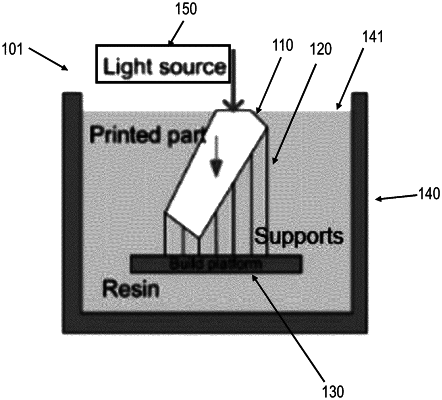| CPC B29C 64/135 (2017.08) [B29C 64/268 (2017.08); B29C 64/40 (2017.08); B29C 71/0009 (2013.01); B33Y 10/00 (2014.12); B33Y 40/20 (2020.01); B29K 2105/0002 (2013.01); B29K 2105/243 (2013.01)] | 13 Claims |

|
1. A method for manufacturing a three-dimensional object, comprising:
depositing a photopolymerizable material to form a desired three-dimensional object and to form a support structure configured to support the desired three-dimensional object, the deposited material forming one or more interfaces between the desired three-dimensional object and the support structure, the one or more interfaces being one or more locations at which the desired three-dimensional object is configured to be separated from the support structure;
modulating material properties of the one or more interfaces such that an application of a threshold force proximate to or at the one or more interfaces allows the desired three-dimensional object to be separated from the support structure, a value of the threshold force being less than a value of a fracture force at which the desired three-dimensional object fractures;
at least partially curing at least a portion of the deposited material proximate to or at the one or more interfaces using light from a light source; and
wherein modulating material properties of the one or more interfaces further comprises selectively lowering a tensile strength of the one or more interfaces relative to the object or decreasing a ductility of the one or more interfaces relative to the object by at least one of: (a) adjusting an intensity of exposure of the deposited material proximate to or at the one or more interfaces to the light from the light source or (b) adjusting a spatial distribution of exposure of the deposited material proximate to or at the one or more interfaces to the light from the light source,
wherein modulating material properties of the one or more interfaces comprises generating residual polymerization stress at the one or more interfaces by adjusting the intensity of exposure or the spatial distribution of exposure at the one or more interfaces.
|